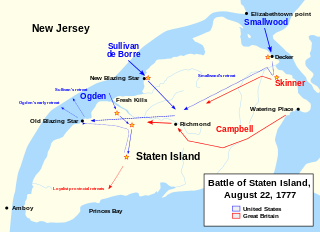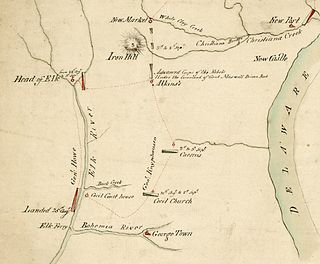Related Research Articles

The Battle of Monmouth, also known as the Battle of Monmouth Court House, was fought near Monmouth Court House in modern-day Freehold Borough, New Jersey on June 28, 1778, during the American Revolutionary War. It pitted the Continental Army, commanded by General George Washington, against the British Army in North America, commanded by General Sir Henry Clinton.

William Crawford was an American military officer and surveyor who worked as a land agent alongside George Washington while Washington was a teenager. Crawford fought in the French and Indian War, Lord Dunmore's War and the American Revolutionary War arising to the rank of Colonel. In 1782, his unit was attacked, and while he and his surgeon escaped for less than one day, Crawford was eventually captured where he was tortured and burned at the stake by Crawford's former soldier turned British agent, Simon Girty, and Captain Pipe, a Chief of the Delaware Nation.

The Battle of Crooked Billet was a battle in the Philadelphia campaign of the American Revolutionary War fought on May 1, 1778 near the Crooked Billet Tavern. In the skirmish action, British forces under the command of Major John Graves Simcoe launched a surprise attack against Brigadier General John Lacey and three regiments of Pennsylvania militia, who were literally caught sleeping. The British inflicted significant damage, and Lacey and his forces were forced to retreat into neighboring Bucks County.

Thomas Hartley was an American lawyer, soldier, and politician from York, Pennsylvania.

The 2nd Canadian Regiment (1776–1783), also known as Congress' Own or Hazen's Regiment, was authorized on January 20, 1776, as an Extra Continental regiment and raised in the province of Quebec for service with the American Continental Army under the command of Colonel Moses Hazen. All or part of the regiment saw action at Staten Island, Brandywine, Germantown and the Siege of Yorktown. Most of its non-combat time was spent in and around New York City as part of the forces monitoring the British forces occupying that city. The regiment was disbanded on November 15, 1783, at West Point, New York.
The 2nd New Jersey Regiment was raised, on 9 October 1775, at Trenton, New Jersey, for service with the Continental Army under the command of Colonel William Maxwell. The regiment would see action at the Battle of Trois-Rivières, Battle of Valcour Island, Battle of Brandywine, Battle of Germantown, Battle of Crooked Billet, Battle of Monmouth, Sullivan Expedition, Battle of Springfield and the Battle of Yorktown. The regiment was furloughed, on 6 June 1783, at Newburgh, New York, and disbanded 3 November 1783.
The 8th Pennsylvania Regiment or Mackay's Battalion was an American infantry unit that became part of the Continental Army during the American Revolutionary War. Authorized for frontier defense in July 1776, the eight-company unit was originally called Mackay's Battalion after its commander, Colonel Aeneas Mackay. Transferred to the main army in November 1776, the unit was renamed the 8th Pennsylvania Regiment on 1 January 1777. It completed an epic winter march from western Pennsylvania to New Jersey, though Mackay and his second-in-command both died soon afterward. In March 1777 Colonel Daniel Brodhead assumed command. The regiment was engaged at the Battles of Bound Brook, Brandywine, Paoli, and Germantown in 1777. A body of riflemen were detached from the regiment and fought at Saratoga. Assigned to the Western Department in May 1778, the 8th Pennsylvania gained a ninth company before seeing action near Fort Laurens and in the Sullivan Expedition in 1778 and 1779. The regiment consolidated with the 2nd Pennsylvania Regiment in January 1781 and ceased to exist.
The 11th Pennsylvania Regiment or Old Eleventh was authorized on 16 September 1776 for service with the Continental Army. On 25 October, Richard Humpton was named colonel. In December 1776, the regiment was assigned to George Washington's main army and was present at Assunpink Creek and fought at Princeton in January 1777. During the spring, the unit assembled at Philadelphia, Pennsylvania in a strength of eight companies. The soldiers were recruited from Philadelphia and four nearby counties. On 22 May 1777, the regiment became part of the 2nd Pennsylvania Brigade. The 11th was in the thick of the action at Brandywine, Paoli, and Germantown in 1777. It was present at White Marsh and Monmouth. On 1 July 1778, the unit was consolidated with the 10th Pennsylvania Regiment, and the 11th Regiment ceased to exist. Humpton took command of the reorganized unit.
The 13th Pennsylvania Regiment, also known as The Pennsylvania State Rifle Regiment and Miles's Regiment, was raised March 6, 1776, as a state militia regiment and later for service with the Continental Army. The regiment would see action during the New York Campaign, Battle of Trenton, Battle of Princeton, Battle of Brandywine, Battle of Germantown and the Battle of Monmouth. The regiment was merged into the 2nd Pennsylvania Regiment on July 1, 1778.

The 1st Continental Light Dragoons, also known as Bland's Horse, was a mounted regiment of the Continental Army organized between 13 June and 10 September 1776 in Williamsburg, Virginia. It was made up of men from eastern and northern Virginia for service with the Continental Army.
The 8th Virginia Regiment or German Regiment was an infantry unit that served in the Continental Army during the American Revolutionary War. Authorized in January 1776, the regiment was raised from men of several northwestern counties in the strength of 10 companies. Its first commander was Colonel Peter Muhlenberg, a clergyman and militia leader. The unit marched to defend Charleston, South Carolina in 1776, but saw no fighting. At the start of 1777, the 8th Virginia moved to join George Washington's main army. When Muhlenberg was promoted to general officer, Colonel Abraham Bowman took command of the unit.
The 1st North Carolina Regiment of the Continental Army was raised on September 1, 1775, at Wilmington, North Carolina. In January 1776 the organization contained eight companies. Francis Nash was appointed colonel in April 1776. The regiment was present at the defense of Charleston in 1776. It transferred from the Southern Department to George Washington's main army in February 1777. At that time, Thomas Clark became colonel of the 1st Regiment. The regiment became part of General Francis Nash's North Carolina Brigade in July.

The 69th Pennsylvania Infantry was an infantry regiment in the Union army during the American Civil War.
William Maxwell was an Irish-born brigadier general in the Continental Army during the American Revolutionary War.

The Maryland and Virginia Rifle Regiment, most commonly known as Rawlings' Regiment in period documents, was organized in June 1776 as a specialized light infantry unit of riflemen in the Continental Army during the American Revolutionary War. The American rifle units complemented the predominant, musket-equipped, line infantry forces of the war with their long-range marksmanship capability and were typically deployed with the line infantry as forward skirmishers and flanking elements. Scouting, escort, and outpost duties were also routine. The rifle units' battle formation was not nearly as structured as that of the line infantry units, which employed short-range massed firing in ordered linear formations. The riflemen could therefore respond with more adaptability to changing battle conditions.

The Battle of Staten Island was a failed raid by Continental Army troops under Major General John Sullivan against British forces on Staten Island on August 22, 1777, during the American Revolutionary War. After British Lieutenant General William Howe sailed with most of his army from New York City in July, Sullivan recognized that the British position on Staten Island was vulnerable, and planned an attack. He carried it out in spite of commanding general George Washington's request that Sullivan reinforce the main army with his troops as soon as possible to support Washington's planned Colonial assault on British-held Philadelphia.
Malcolm's Additional Continental Regiment was one of the sixteen Additional Continental regiments authorized by the Second Continental Congress for the Continental Army. The regiment's colonel was William Malcolm, a wealthy New York City merchant, and its lieutenant colonel was Aaron Burr.

The Battle of Cooch's Bridge, also known as the Battle of Iron Hill, was a battle fought on September 3, 1777, between the Continental Army and American militia and primarily German soldiers serving alongside the British Army during the American Revolutionary War. It was the only significant military action during the war on the soil of Delaware, and it took place about a week before the major Battle of Brandywine. Some traditions claim this as the first battle which saw the U.S. flag.
Mordecai Buckner was born in colonial Virginia and served as an officer in the French and Indian War. After the start of the American Revolutionary War he was appointed colonel of the 6th Virginia Regiment. He served in this capacity for about one year before he was cashiered and dismissed from the Continental Army. Buckner was the son of Thomas Buckner, a planter of Caroline Co., Virginia, who served as a justice of the peace and sheriff of that county, and Mary Timson. He married Elizabeth Beverly Chew in 1767 and the couple had at least two known children.
Spencer's Additional Continental Regiment, sometimes referred to as the 5th New Jersey Regiment, was an American infantry unit that served for four years in the Continental Army during the American Revolutionary War. The Continental Congress authorized sixteen "Additional" Continental Regiments in late 1776 and Colonel Oliver Spencer accepted command of this regiment with rank from January 15, 1777.
References
- 1 2 Benemann, William (2006), Male-Male Intimacy in Early America: Beyond Romantic Friendships, Haworth Press, ISBN 1-56023-345-1
- ↑ "Court-Martial record of Lieutenant Frederick Gotthold Enslin, March 10, 1778". National Archives Foundation. Retrieved 2023-08-07.
- ↑ Shilts, Randy (2005). Conduct Unbecoming: Gays and Lesbians in the U.S. Military. Macmillan. ISBN 978-0-312-34264-7.
- ↑ I. Daniel Rupp, A collection of upwards of thirty thousand names of German, Swiss, Dutch, French and other immigrants in Pennsylvania from 1727-1776 , p. 416. Philadelphia: Stuart Leary, 1927.
- ↑ "Amending America: LGBTQ Human and Civil Rights". National Archives. 2016-08-15. Retrieved 2023-08-07.
- ↑ The Writings of George Washington from the Original Manuscript Sources 1745-1799, Vol. 11 , John C. Fitzpatrick, Ed., United States Government Printing Office, 1934.
- ↑ James McMichael, Pennsylvania Archives (Second Series) , William Henry Egle, ed., v.15, p. 217. Harrisburg, PA: E.K. Meyers, State Printer, 1890.